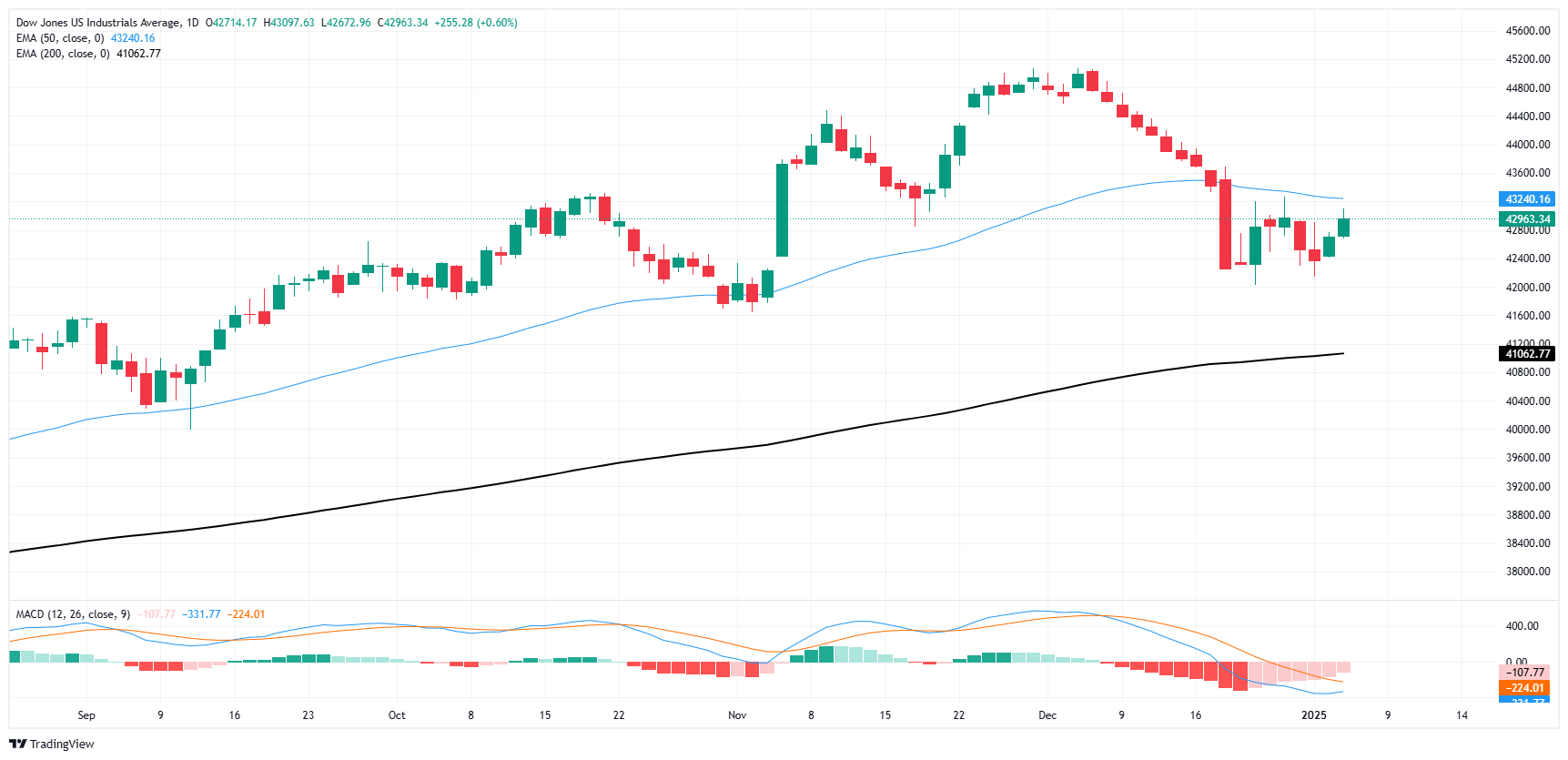Dow Jones Industrial Average lurches higher as investors brush off PMI miss
- The Dow Jones clambered back over the 43,000 level on Monday.
- Market sentiment rose after a report that the Trump team might trim tariff plans.
- Final US S&P Global PMIs missed Wall Street forecasts in December but still rose.
The Dow Jones Industrial Average (DJIA) extended into the bullish side to kick off the new trading week, clipping back over the 43,000 handle and lurching 300 points higher after a Washington Post article suggested that incoming President Donald Trump and his team may be considering a more nuanced approach to widespread tariffs the President-elect has threatened to impose shortly after taking office.
Former and returning President Donald Trump was quick to voice resistance to the article, claiming that the Post story was wrong and that the incoming President still intends to impose a sweeping tariff package against most of the US’ closest allies and trading partners. Investors shrugged off the back-and-forth, clinging to the hopes that President Trump will be dissuaded from imposing what amounts to a flat 20% import tax on US consumers.
Final US S&P Global Purchasing Managers Index (PMI) figures somewhat missed the mark on Monday, with the Composite and Services PMIs for December both climbing from one month to the next, albeit less than analysts expected. Both indicators saw a slight downward revision from their preliminary prints, but still gained ground as the US economy churns on.
Dow Jones news
Markets are looking to reignite the tech rally juggernaut in 2025, pushing chipmakers higher and dragging most of the market higher alongside them. Nvidia (NVDA) soared over 4.5%, climbing above $151 per share. A distant second place goes to Goldman Sachs (GS) which rose around 2% to $590 per share.
Dow Jones price forecast
After a tepid start to the new trading year, the bulls are back on the block and the Dow Jones is getting pushed back above the 43,000 handle as bidders try to regain lost ground following the DJIA’s most recent downside plunge. The Dow Jones has rebounded 2.3% from a near-term swing low into the 42,000 region, but bidders still need to drag price action back above the 50-day Exponential Moving Average (EMA) at 43,225 before the bull market can be declared renewed.
Dow Jones daily chart
Dow Jones FAQs
The Dow Jones Industrial Average, one of the oldest stock market indices in the world, is compiled of the 30 most traded stocks in the US. The index is price-weighted rather than weighted by capitalization. It is calculated by summing the prices of the constituent stocks and dividing them by a factor, currently 0.152. The index was founded by Charles Dow, who also founded the Wall Street Journal. In later years it has been criticized for not being broadly representative enough because it only tracks 30 conglomerates, unlike broader indices such as the S&P 500.
Many different factors drive the Dow Jones Industrial Average (DJIA). The aggregate performance of the component companies revealed in quarterly company earnings reports is the main one. US and global macroeconomic data also contributes as it impacts on investor sentiment. The level of interest rates, set by the Federal Reserve (Fed), also influences the DJIA as it affects the cost of credit, on which many corporations are heavily reliant. Therefore, inflation can be a major driver as well as other metrics which impact the Fed decisions.
Dow Theory is a method for identifying the primary trend of the stock market developed by Charles Dow. A key step is to compare the direction of the Dow Jones Industrial Average (DJIA) and the Dow Jones Transportation Average (DJTA) and only follow trends where both are moving in the same direction. Volume is a confirmatory criteria. The theory uses elements of peak and trough analysis. Dow’s theory posits three trend phases: accumulation, when smart money starts buying or selling; public participation, when the wider public joins in; and distribution, when the smart money exits.
There are a number of ways to trade the DJIA. One is to use ETFs which allow investors to trade the DJIA as a single security, rather than having to buy shares in all 30 constituent companies. A leading example is the SPDR Dow Jones Industrial Average ETF (DIA). DJIA futures contracts enable traders to speculate on the future value of the index and Options provide the right, but not the obligation, to buy or sell the index at a predetermined price in the future. Mutual funds enable investors to buy a share of a diversified portfolio of DJIA stocks thus providing exposure to the overall index.

